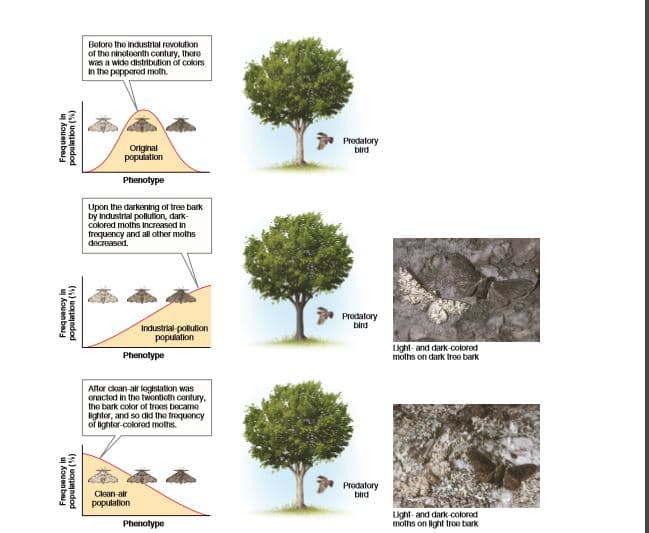Before the industrial revolution of the nineteenth century, there was a wide distribution of colors In the peppered moth. Predatory bird Original population Phenotype Upon the darkening of tree bark by Industrial pollution, dark- colored moths increased in frequency and all other moths decreased. Prodatory bird Industrial polution population Light- and dark-colored moths on dark tree bark Phenotype After clean-air legistation was enacted in the tworntieth century, the bark color of trees became lighter, and so did the froquency of lighter-colored moths. Predatory bird Clean-air population Light- and dark-colored moths on light troe bark Phenotype (%) uopendod (%) uopejndod u kouenbe (%) uopendod Frequency in Frequency in
Before the industrial revolution of the nineteenth century, there was a wide distribution of colors In the peppered moth. Predatory bird Original population Phenotype Upon the darkening of tree bark by Industrial pollution, dark- colored moths increased in frequency and all other moths decreased. Prodatory bird Industrial polution population Light- and dark-colored moths on dark tree bark Phenotype After clean-air legistation was enacted in the tworntieth century, the bark color of trees became lighter, and so did the froquency of lighter-colored moths. Predatory bird Clean-air population Light- and dark-colored moths on light troe bark Phenotype (%) uopendod (%) uopejndod u kouenbe (%) uopendod Frequency in Frequency in
Biology: The Unity and Diversity of Life (MindTap Course List)
15th Edition
ISBN:9781337408332
Author:Cecie Starr, Ralph Taggart, Christine Evers, Lisa Starr
Publisher:Cecie Starr, Ralph Taggart, Christine Evers, Lisa Starr
Chapter43: Animal Behavior
Section: Chapter Questions
Problem 3DAA
Related questions
Question
If one extreme phenotype makes up most of a population after directional selection, what happened to the individuals with the other

Transcribed Image Text:Before the industrial revolution
of the nineteenth century, there
was a wide distribution of colors
In the peppered moth.
Predatory
bird
Original
population
Phenotype
Upon the darkening of tree bark
by Industrial pollution, dark-
colored moths increased in
frequency and all other moths
decreased.
Prodatory
bird
Industrial polution
population
Light- and dark-colored
moths on dark tree bark
Phenotype
After clean-air legistation was
enacted in the tworntieth century,
the bark color of trees became
lighter, and so did the froquency
of lighter-colored moths.
Predatory
bird
Clean-air
population
Light- and dark-colored
moths on light troe bark
Phenotype
(%) uopendod
(%) uopejndod
u kouenbe
(%) uopendod
Frequency in
Frequency in
Expert Solution
This question has been solved!
Explore an expertly crafted, step-by-step solution for a thorough understanding of key concepts.
Step by step
Solved in 3 steps

Knowledge Booster
Learn more about
Need a deep-dive on the concept behind this application? Look no further. Learn more about this topic, biology and related others by exploring similar questions and additional content below.Recommended textbooks for you

Biology: The Unity and Diversity of Life (MindTap…
Biology
ISBN:
9781337408332
Author:
Cecie Starr, Ralph Taggart, Christine Evers, Lisa Starr
Publisher:
Cengage Learning

Biology: The Unity and Diversity of Life (MindTap…
Biology
ISBN:
9781305073951
Author:
Cecie Starr, Ralph Taggart, Christine Evers, Lisa Starr
Publisher:
Cengage Learning

Concepts of Biology
Biology
ISBN:
9781938168116
Author:
Samantha Fowler, Rebecca Roush, James Wise
Publisher:
OpenStax College

Biology: The Unity and Diversity of Life (MindTap…
Biology
ISBN:
9781337408332
Author:
Cecie Starr, Ralph Taggart, Christine Evers, Lisa Starr
Publisher:
Cengage Learning

Biology: The Unity and Diversity of Life (MindTap…
Biology
ISBN:
9781305073951
Author:
Cecie Starr, Ralph Taggart, Christine Evers, Lisa Starr
Publisher:
Cengage Learning

Concepts of Biology
Biology
ISBN:
9781938168116
Author:
Samantha Fowler, Rebecca Roush, James Wise
Publisher:
OpenStax College

Biology Today and Tomorrow without Physiology (Mi…
Biology
ISBN:
9781305117396
Author:
Cecie Starr, Christine Evers, Lisa Starr
Publisher:
Cengage Learning